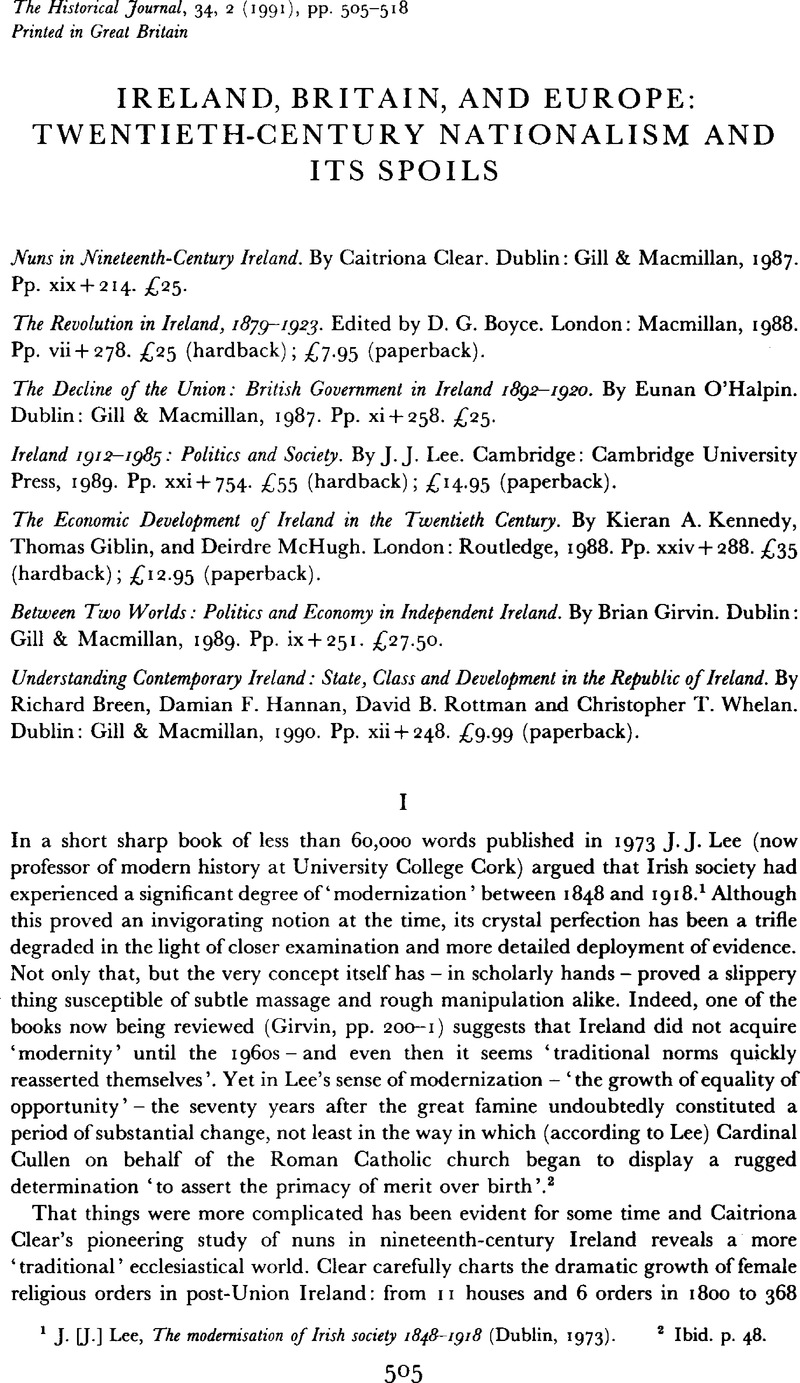No CrossRef data available.
Published online by Cambridge University Press: 11 February 2009

1 Lee, J.[J]., The modernisation of Irish society 1848–1918 (Dublin, 1973)Google Scholar.
2 Ibid. p. 48.
3 I follow Clear (and others) in applying the terms ‘nun’ and ‘order’ to women religious and their organizations generally, though, canonically speaking, they refer only to enclosed religious.
4 O'Brien, Susan, ‘“Terra incognita”: The nun in nineteenth-century England’, Past and Present, no. 121 (1988), 110–40CrossRefGoogle Scholar.
5 Ibid. Interestingly, in England serious efforts were made to break down choir/lay distinctions.
6 Ireland and the death of kindness: the experience of constructive unionism 1890–1905 (Cork, 1987)Google Scholar.
7 McDowell, R. B., The Irish administration 1801–1914 (London, 1964)Google Scholar. But see also Flanagan, K., ‘The chief secretary's office, 1853–1914: a bureaucratic enigma’, Irish Historical Studies, XXIV (1984). 197–225CrossRefGoogle Scholar.
8 Readers should be warned that the paperback edition (which is all that a mean-minded publisher supplies even to unpaid reviewers) is hopelessly uncomfortable to handle and also inadequately bound.
9 Fanning, R., Independent Ireland (Dublin, 1983), p. 58Google Scholar.
10 The serious drawbacks of the Free State's ‘British model’ approach have already been fruitfully discussed by Fanning, Ronan in, for example, The Irish department of finance 1922–58 (Dublin, 1978)Google Scholar, Independent Ireland, and ‘Britain's legacy: government and administration’ in Drudy, P. J. (ed.), Ireland and Britain since 1922: Irish Studies 5 (Cambridge, 1986), pp. 45–64Google Scholar.
11 Dugdale, Blanche E. C., Arthur James Balfour, first earl of Balfour, 2 vols. (London, 1936), II, 392Google Scholar.
12 Hannan, D. F., Displacement and development: class, kinship and social change in Irish rural communities (Dublin, 1979), pp. 32–3Google Scholar.
13 See also Bew, P., Gibbon, P. and Patterson, H., The state in Northern Ireland 1921–72: political forces and social classes (Manchester, 1979), pp. 76–82Google Scholar.
14 Girvin, also expresses concern (more consistently in his case) about ‘government by specialists, in particular accountants and economists’ (p. 210)Google Scholar.
15 See, for example, the discussion of the Dunbar–Harrison episode of 1930–1 (pp. 161–7).
16 Little is made of the catholic church's marriage laws, especially the Ne Temere decree of 1908, although Lee does mention (p. 11) another curiously named decree which he calls Motu Proprio. A Motu Proprio is in fact a particular kind of ordinance originating directly from the pope.
17 Kennedy, K. and Dowling, B. R., Economic growth in Ireland: the experience since 1947 (Dublin, 1975). PP. 231–2Google Scholar.
18 For example: Kennedy, and Dowling, , Economic growth, p. 253Google Scholar; Walsh, B. M., ‘Economic growth and development, 1945–70’ in Lee, J. [J.] (ed.), Ireland 1945–70 (Dublin, 1979), p. 36Google Scholar; Brown, T., Ireland: a social and cultural history 1922–79 (London, 1981), p. 241Google Scholar; Gillmor, D. A., Economic activities in the Republic of Ireland: a geographical perspective (Dublin, 1985), p. 10Google Scholar.
19 Cited Blackwell, J., ‘Government, economy and society’ in Litton, F. (ed.), Unequal achievement: the Irish experience 1957–1982 (Dublin, 1982), p. 52Google Scholar. See also Lee, , Ireland 1912–1985, p. 364Google Scholar. Despite Whitaker, social spending expanded in real terms between 1958 and 1963, though it did decline relative to capital spending (Kennedy, and Dowling, , Economic growth in Ireland, pp. 226–7)Google Scholar.
20 Raymond, R. J., ‘De Valera, Lemass and Irish economic development: 1933–1948’ in O'Connell, J. P. and Murphy, J. A. (eds.), De Valera and his times (Cork, 1983), p. 128Google Scholar.
21 If McElligott had uttered these words, Lee would doubtless have taken them at face value. In Whitaker's case, however, they are immediately given a friendlier gloss.
22 Hoppen, K. T., Ireland since 1800: conflict and conformity (London, 1989), pp. 218–24Google Scholar.
23 Rottman, D. B. and O'Connell, P. J., ‘The changing social structure’ in Litton, (ed.), Unequal achievement, p. 75Google Scholar.
24 Craig, Patricia, ‘Dazzling front lines’, Independent, 25 08 1990, p. 29Google Scholar, quoting from ‘Peasant qualities’ in Simmons's, West Strand visions (Belfast, 1974), p. 31Google Scholar.
25 Kavanagh, P., Collected pruse [sic] (London, 1967), pp. 282–3Google Scholar.